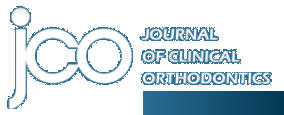Search Results For: 'case report'
401.
Bass Orthopedic Appliance System, Part 3: Case Management
Volume 21 : Number 6 : Page 0 : Jun 1987
Patient Motivation It is important to recognize that the dentofacial features that make up a skeletal Class II malocclusion belong to an individual person. From the initial visit the orthodontist must...
402.
Organization and Strategy of a Delegated Case Presentation
Volume 17 : Number 10 : Page 692 : Oct 1983
Orthodontists have traditionally delegated reversible clinical tasks to properly trained personnel under their direct supervision as a logical extension of the doctor's capability and one with which m...
403.
Ten Tips for Improving Your Case Acceptance Ratio
Volume 27 : Number 1 : Page 0 : Jan 1993
Nationwide statistics have shown that only about 55 percent of patients who have initial consultations actually start orthodontic treatment. I know from working in orthodontic offices across the count...
404.
BOOK REVIEWS
Atlas of Orthodontic Case Reviews
Volume 53 : Number 3 : Page 170 : Mar 2019
MARJAN ASKARI, DMD, MSSTANLEY A. ALEXANDER, DMD 280 pages, more than 800 clinical photographs. $124.99. 2017.Wiley-Blackwell, 111 River St., Hoboken, NJ 07030. (877) 762-2974; www.wiley.com. Reviewing...
405.
Volume 6 : Number 11 : Page 635 : Nov 1972
DISCLAIMER The views expressed herein are those of the authors and do not necessarily reflect the views of the United States Air Force or the Department of Defense. The following case illustrates the ...
406.
The Case of the Talented Trumpeter
Volume 9 : Number 2 : Page 106 : Feb 1975
Whenever I hear a discussion of the effects of musical instruments on the teeth and vice versa, I think of the case of the talented trumpeter. This boy showed exceptional ability with the trumpet at a...
407.
THE EDITOR'S CORNER
Volume 42 : Number 2 : Page 69 : Feb 2008
As readers of this column will probably recall, one of my pet peeves is inadequate records. Nothing is more discouraging for an editor than to receive a manuscript that contains information on somethi...
408.
TECHNIQUE CLINIC
Bell-Shape Bonded Lingual Splint
Volume 28 : Number 6 : Page 364 : Jun 1994
Bonded lingual wire splints are quite useful in retaining closure of maxillary midline diastemas, but these splints often fail because of excessive occlusal forces. Bending an .0195" twisted wire into...
409.
Improving Your Case Acceptance Rate
Volume 26 : Number 10 : Page 0 : Oct 1992
Selling is a concept that is misunderstood by many orthodontists and their staff members. We agree that we must "sell the case", but no one wants to use "selling" techniques to do so. This is because ...
410.
ORTHODONTIC OFFICE DESIGN The Case for Ownership
Volume 40 : Number 4 : Page 243 : Apr 2006
Powerful intangibles come into play when we discuss the topic of ownership. Although the advantages of outright ownership of a practice facility have always been evident to orthodontists, one person's...
411.
Orthodontic Treatment of a Case with Minimal Periodontal Support
Volume 27 : Number 6 : Page 0 : Jun 1993
An adult female presented to our clinic with a periodontally involved malocclusion induced by severe gingival overgrowth (Fig. 1). The periodontal condition was due to four years' use of sodium diphen...
412.
Bonneville Orthodontic Seminar, Part IV: The Borderline Extraction Case
Volume 3 : Number 10 : Page 531 : Oct 1969
One of the most important objectives in orthodontic treatment is to improve the harmony of the lips, nose, and chin or maintain a harmonious relationship already present prior to treatment. It can be ...
413.
A Case Study in Professional Cooperation
Volume 21 : Number 7 : Page 0 : Jul 1987
Open warfare broke out in San Antonio when the San Antonio Express-News published an article on April 28, 1985, in which the differences between orthodontists and general dentists were brought to publ...
414.
Volume 22 : Number 11 : Page 0 : Nov 1988
Orthodontists enjoy a high level of patient appreciation, partly because their results are almost always an esthetic improvement. Still, many orthodontists finish treatment short of the finest possibl...
415.
Self-Analysis of Case Acceptance Rate
Volume 24 : Number 2 : Page 0 : Feb 1990
The availability of patients and their acceptance of treatment depend on numerous factors, including practice location, the local economy, the skill and reputation of the orthodontist and staff, and t...
416.
Volume 23 : Number 1 : Page 0 : Jan 1989
The computer-aided axiograph (CADIAX) produces more precise measurements of hinge-axis movements than the manual axiograph, and it also provides additional tracking data (see Part 7, JCO, December 198...
417.
Treatment of the Class II Division 1 Four Bicuspid Extraction Case with the Johnson Twin Arch
Volume 4 : Number 1 : Page 44 : Jan 1970
In 1946 Doctor Johnson wrote that he hesitated to write a paper on extractions, the reason being that he didn't want some to think that he was carried away by the then present extraction wave. I extra...
418.
Volume 2 : Number 6 : Page 0 : Jun 1968
Proponents of Edgewise technique 1,2,3,4,5 may disagree about treatment timing, facial aesthetics, expansion, extraction, retention and optimum bracket and wire sizes. However, in the 'moment of truth...
419.
Volume 40 : Number 4 : Page 250 : Apr 2006
A variety of dental and skeletal conditions can exist within the dolichocephalic population. Figure 13A illustrates a patient with a severe open bite and an acceptable smile line in which the occlusal...
420.
Volume 3 : Number 6 : Page 316 : Jun 1969
In this day of space probes, heart transplants and .014 torquing arches it may seem old hat to discuss an appliance such as the Johnson Twin Arch. However, perhaps the reader may profit from its seemi...
Showing 401-420 of 3208 results. Search completed in 0.155 seconds.

